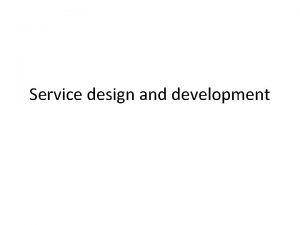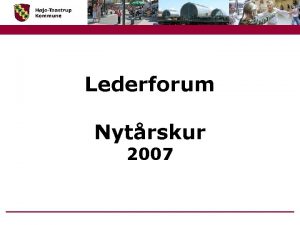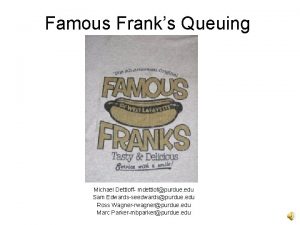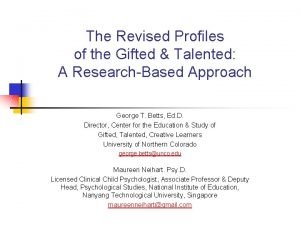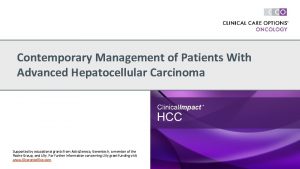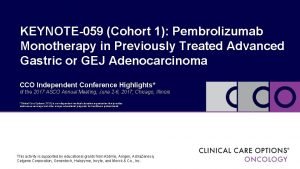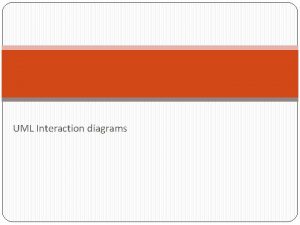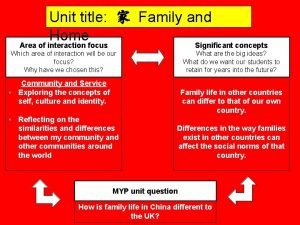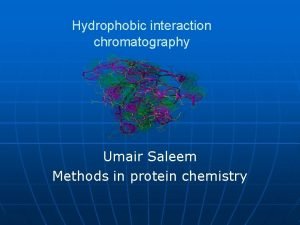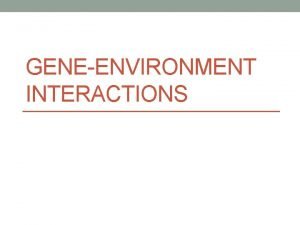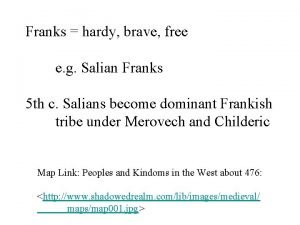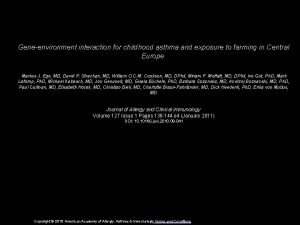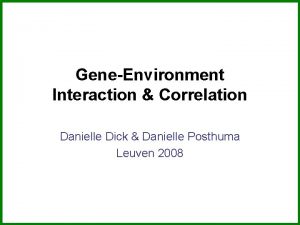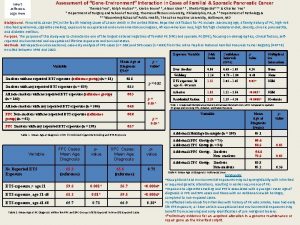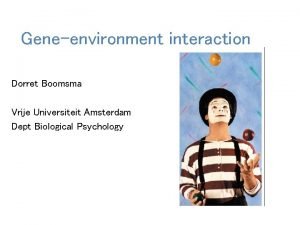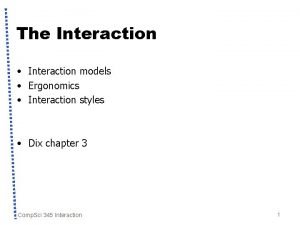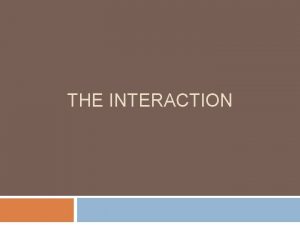Keynote Lecture GeneEnvironment Interaction Paul W Franks Ph



























- Slides: 27

Keynote Lecture: Gene-Environment Interaction Paul W Franks Ph. D MPhil MS Assoc. Prof. Experimental Medicine Genetic Epidemiology & Clinical Research Group Department of Public Health & Clinical Medicine Umeå University Hospital Sweden ICPAPH Amsterdam - 2008

“Genes load the gun and the environment pulls the trigger” Anonymous >99. 9% of modern human evolution <0. 1% of modern human evolution (>1000 s of generations) (~5 generations)

How have evolutionary pressures influenced the adaptation of the human genome and how does this affect disease risk? Genotypes that maximise immunity, fertility & earlylife survival in a physically demanding environment will have been selected for Adipose tissue is integral to fertility and immunity and, because it is highly energetic, was advantagous in early life Logical that our genome is enriched with genes that protect against leanness, promote fatness, and requires energetic stress to function properly


Global prevalence of type 2 diabetes in selected populations Adapted from: King & Rewers (Diab Care, 1993)

Type 2 diabetes incidence in Pimas born to women with varying levels of gestational glucose tolerance Mothers’ gestational 2 hr glucose levels Franks PW, et al. (Diabetes. 2006)

Childhood predictors of type 2 diabetes in Pima Indians Perfect prediction 100 Waist circ. 90 ROC AUC (%) BMI, Hb. A 1 c, 2 hr gluc. Waist, Hb. A 1 c, 2 hr gluc. 80 70 60 Zero prediction 50 5 -9 yrs 10 -15 yrs Age 15 -20 yrs All predictor traits combined: BMI, waist circumference, fasting glucose, 2 hr glucose, Hb. A 1 c, fasting insulin, triglycerides, HDL-C, SBP, DBP Franks PW, et al. (Diabetes. 2007)


Gene (11 BHSD 1) x environment interactions on blood pressure in 20 -30 yr old Pima Indians born in different eras (Total exams = 4, 764) 110 Main effect p=0. 0006 Gene x time interaction p= 0. 01 105 Mean Arterial Pressure (mm. Hg) GG GA 100 AA 95 90 85 80 70 1940 -50 1950 -60 1960 -70 1970 -80 Birth-era Time = environmental change Franks PW, et al (Hypertension, 2004)

The history of type 2 diabetes molecular genetics Risk of diabetes (Odds ratio) Biologic candidate approach Positional cloning Hypothesis-free approach 1. 40 TCF 7 L 2 1. 35 1. 30 1. 25 PPARG 1. 20 CDKN 2 A-2 B FTO HHEX-IDE SLC 30 A 8 CDKAL 1 IGF 2 BP 2 WFS 1 KCNJ 11 1. 15 1. 10 1. 05 1. 00 TCF 2 1998 1999 2000 2001 2002 2003 Year 2004 2005 2006 2007

DIAGRAM Consortium, Nat Genet (Epub 2008)

Replication of the TCF 7 L 2 genotype association with type 2 diabetes in the Diabetes Prevention Program • • • Individuals at high risk of diabetes (IGT and overweight/obese) Randomized to placebo, metformin or lifestyle intervention (or troglitazone) Followed for 3. 2 years – longitudinal analysis 68% women, 32% men ~3400 subjects genotyped Hispanic American 508 (16%) Asian/Pacific Islander 142 (4%) American Indian 171 (5%) African American 645 (20%) European American 1768 (55%) Knowler et al. NEJM, 2002 • Max weight loss was at 1 year into the trial


A gene-lifestyle interaction occurs when the effect of a lifestyle exposure on a disease trait differs in magnitude between genetic subgroups Disease trait Genotype Physical activity level

Thinking through the mechanisms before testing the hypotheses (the biologic candidate gene approach) Environmental exposures Lifestyle exposures high risk genotype Hormone flux Substrate flux Hypoxia Ca 2+ charge n ion tio ir pt a l c s m. RNA ans an r r T T Shear stress Mechanical stretch Energy charge Oxidative stress Nutrients Pharmacotherapy wildtype Disease Risk

Selecting candidate genes for interactions A candidate gene for interaction should: 1. encode a protein necessary for the development of the disease phenotype (or regulate other such genes or proteins) 2. be characterized by functional variation within its nucleotide sequence 3. be induced or repressed when exposed to the lifestyle factor N. B. : the “interaction” between genes and lifestyle factors that are not on the same causal pathway is highly improbable (additive effects predicted)

Gln 27 Gln Glu 27 X BMI (kg/m 2) Waist (cm) Physical activity (PAL) Sedentary Physically active

Meta-analysis of association between Pro 12 Ala genotype and BMI P<0. 05 Tönjes et al. , Diab Care (2006)

- Thiazolidinediones (TZD) - Polyunsaturated fats (PUFA) Physical activity ? ? ? PPAR γ RA Adipocyte differentiation Insulin sensitivity RXR PPRE Lipid & glucose metabolism Inflammation Muller & Kersten, Nat Rev Genet (2003) Deeb et al. , Nat Genet (1998) Luan et al. , Diabetes (2001)

Franks et al. , Diabetologia (2007)

Franks et al. , Diabetologia (2007)

Heritability of obesity ~80% Obesity BMI-z per risk allele: 1 -1. 5 kg increase in weight 16% Homozygous for risk allele 30% increased risk for obesity 40% Heterozygous for risk allele Slide courtesy of Ruth Loos

Andreasen et al Diabetes 2008

Summary Bona fide GEIs: • are informative of the molecular mechanisms of disease • help refine the search for ‘risk’ genes • enable subgroups of the population that are susceptible to disease in specific environments to be identified • may help define why some respond well to exercise intervention and others respond poorly

What might the future hold? • Genome-guided treatment ? (see: Roth SM, J Appl Physiol, 2008; Hunter DJ, NEJM, 2008) • Increased treatment effectiveness? • Fewer unnecessary side-effects? • Improved patient adherence? Now is the time to initiate translational research


Acknowledgments • • William Knowler MD Dr. PH (NIH, Phoenix) Nick Wareham FRCP Ph. D (MRC, Cambridge) Jose Florez MD Ph. D (Harvard, Boston) Many others Genetic Epidemiology & Clinical Research Group, Umeå: • Frida Renström, Anna Söderberg, Ema Brito, Monica Holmgren, Nicklas Fridberg, Lotta Parkstad • • Swedish Diabetes Association Swedish Heart-Lung Foundation Novo Nordisk Västerbotten’s Health Authority National Institutes of Health European Union Medical Research Council paul. franks@medicin. umu. se
 Customer service blueprint
Customer service blueprint Franks lederforum
Franks lederforum Dennis frank 美安
Dennis frank 美安 Anne franks real name
Anne franks real name Famous franks food truck
Famous franks food truck Lane v franks
Lane v franks Western europe after the fall of rome
Western europe after the fall of rome Amy franks artist
Amy franks artist Keynote assessment
Keynote assessment Advantages of microsoft powerpoint
Advantages of microsoft powerpoint U god keynote speaker zip
U god keynote speaker zip Profiles of the gifted and talented
Profiles of the gifted and talented Keynote-524
Keynote-524 Keynote-059
Keynote-059 Keynote-010
Keynote-010 Keynote-010
Keynote-010 01:640:244 lecture notes - lecture 15: plat, idah, farad
01:640:244 lecture notes - lecture 15: plat, idah, farad Maypole interaction pattern
Maypole interaction pattern Perceptual region definition
Perceptual region definition Uml interaction diagram
Uml interaction diagram Area of interaction
Area of interaction Interaction design basics
Interaction design basics Hydrophobic interaction chromatography slideshare
Hydrophobic interaction chromatography slideshare Stata margins continuous categorical interaction
Stata margins continuous categorical interaction Elements of the wimp interface
Elements of the wimp interface To open a new text window in small basic
To open a new text window in small basic Barnard's parent child interaction model
Barnard's parent child interaction model Schéma interaction sur le web pix
Schéma interaction sur le web pix
